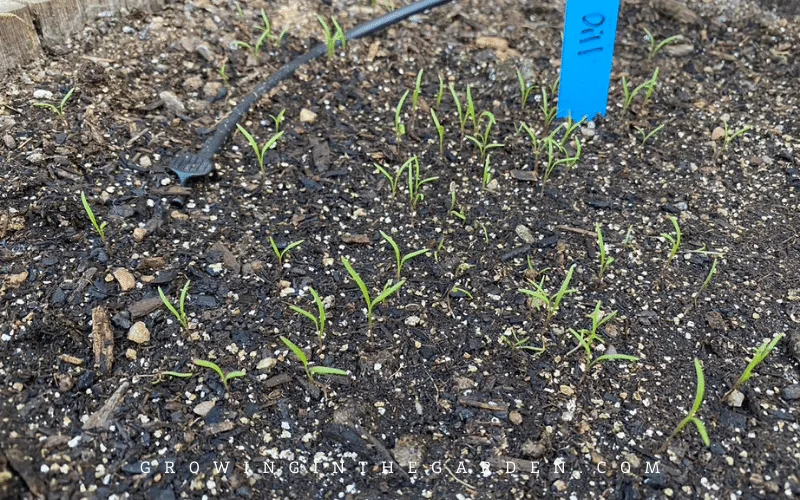[ad_1]

I really like utilizing recent dill from the backyard as a flavorful herb in cooking. Snipping just a few leaves and including them to dips, sauces, fish, and roasted greens is extremely handy and scrumptious. Moreover, dill helps entice fantastic wildlife to your backyard. Learn to develop dill outdoors, inside, and in containers with these 5 suggestions.

Disclaimer: this publish accommodates affiliate hyperlinks. See my disclosure coverage for extra info.
5 Suggestions for Methods to Develop Dill

1. Plant dill on the proper time
Plant after the final spring frost date. Seeds germinate in soil temperatures starting from 50-70°F (10-21°C). Succession plant dill each three weeks for a continuous harvest of the leaves.
Dill is a cool-season herb that grows greatest throughout fall and winter’s cooler temperatures in sizzling summer season climates. Within the low desert of Arizona, plant dill seeds and transplants starting in October and plant via January.

2. Plant dill appropriately
Attempt rising completely different types of dill, relying in your wants and preferences.
Bouquet dill has massive blooms and seed heads. Glorious for pickling.
Dukat dill is darker inexperienced with massive seed heads. Glorious for pickling.
Fernleaf dill is sluggish to bolt and appropriate for rising indoors and in containers.
Tetra dill is a bushy, late-flowering selection and considerably extra heat-tolerant.
Select a location to plant dill with wealthy, unfastened soil and full solar.
Dill has a protracted taproot; develop from seeds if potential. Dill grown from transplant usually bolts extra shortly than dill grown from seed. For those who plant transplants, select younger transplants and punctiliously deal with the roots.
To plant dill outdoors, plant dill seeds 1/8 inch to 1/4 inch (2-6 mm) deep. Hold the soil moist till the seeds sprout. Skinny seedlings to 12 inches (30 cm) aside when they’re a number of inches tall. Mulch effectively after thinning seedlings.


3. Look after dill appropriately
Hold soil evenly moist. A layer of mulch will assist preserve moisture.
Aphids are a standard pest that infects dill. Decide off the worst affected leaves or anticipate the helpful bugs to come back that can assist you deal with them. Be taught extra about the right way to forestall backyard pests organically on this weblog publish.

Methods to develop dill in containers:
Dill has a protracted taproot and does greatest in containers not less than 18 inches deep.
Dill doesn’t require supplemental feeding.

Methods to develop dill indoors:
Plant dill seeds instantly in an unglazed terra-cotta pot not less than 18 inches deep.
Water dill solely when the highest inch or so of soil is dry.
Present supplemental lighting for dill for 10-11 hours, with the lights about 6 inches from the plant.
Best indoor temperature for dill: 60°F-80°F.
Doesn’t require supplemental feeding.
4. Harvest dill fronds and seeds

Harvesting dill fronds:
Dill leaves are prepared to reap 40-60 days after planting from seed. Start harvesting leaves as soon as the plant has 4-5 leaves. Dill leaves are probably the most aromatic simply earlier than flowering.
Use dill leaves recent or protect them by drying, dehydrating, or freeze drying.



Harvesting dill seeds:
Dill seeds are prepared to reap after 85-115 days. Seeds have one of the best taste if harvested simply as they flip from inexperienced to brown. Harvest seeds by chopping the stalks on the base and storing them the wrong way up in a paper sack. Seeds will fall into the underside of the sack.
To keep away from dill reseeding in your backyard, harvest the seed heads earlier than the seeds dry and start falling off. Be taught extra about the right way to save seeds on this weblog publish.



5. Use dill to draw helpful bugs to your backyard

Dill is scrumptious, however I don’t develop it for the style alone. I get pleasure from planting additional for the wildlife it attracts. Dill flower umbels (clusters of tiny yellow flowers) are nectar-rich and feed quite a few helpful pollinators.
Dill is a superb companion plant and continuously a larval host plant for butterflies. Arizona’s state butterfly, the two-tailed swallowtail larvae, can usually be seen having fun with dill vegetation.


For those who loved this publish about the right way to develop dill, please share it:



[ad_2]
Supply hyperlink